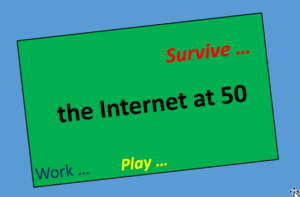Accidental Hero – The Internet (a COVID-19 story)

The Internet celebrated a 50th anniversary in 2019. Designed and built for long distance communication, who would have thought it would be such a marvel for physical distancing, to fight a 2020 pandemic? Each reader, during these unusual times, will have used the Internet in different ways, for services they now depend on. It could be work-from-home, buying food online, or having a remote medical consultation. And each of us may take for granted that the communication power of the Internet is there for us to practice physical separation – but it wasn’t always there, and it certainly was not built for this purpose.
Canadian talent played a leading role – the first search engine “Archie” was developed at McGill University; a cluster of our universities created NetNorth; the BlackBerry was a leader in mobile devices, Nortel and JDS Fitel were leaders in digital infrastructure, ATI Technologies in video cards, and Corel in graphics. The AES Word Processor played a role in a rather rapid transition from printing to e-documents and email.
Ironically, social connection was an important driver in the Internet’s evolution. A simple phone call was originally just a way to chat, however one day a funny thing happened, people tested the phone network for data transmission – and it worked! So we used it for many new applications. Science geeks set up a global web of data connections, and businesses adopted it. Telephones became mobile, as written communication became electronic. Mail became email. Cameras became digital, then got smaller and smaller. Then the global data network was tried for voice communications – and that worked too! Voice calls on the Internet led to video meetings online. Many interconnections were placed on this shared network, and it expanded worldwide.
Then a few even stranger things happened. People started to play games on computers designed for business, and the games started to talk with one another. Computers and phones started to play music – even movies! Consumer applications created markets so large that it became impossible to buy a device that would just help people work. A camera became an accessory inside our phones and computers. This had an interesting side effect. Over a 20 year period, with this mix of “work” and “play” technology, we all became computer literate, as words like mail and text and chat developed new meaning.
The time spent on electronic entertainment ballooned. Greed was a big factor – the terms “click bait” and “big data” entered common conversation. For many applications, designers sought madly to gain more eyeballs and more screen time. Ethics were debated, but as usage grew, revenues grew, and billions were plowed back into network infrastructure. More bandwidth, more fiber, more connections. Streaming video became so common the TV industry was turned upside down. Home Internet connections, common in the 90’s, became faster and faster, then wireless, emerging as pervasive streaming entertainment platforms by 2020. A complex metamorphosis had occurred.
Then COVID-19 arrived. This was a big danger to the community, more than anybody could imagine … a bigger threat than our generation had ever experienced. Overnight, the global play network was used in a new way, for a serious new purpose.
The Internet suddenly became a savior. For the first time in human history, a robust communication network was in place to help us deal with a health care crisis. The Internet made distancing possible – on a widespread basis – and that is saving lives around the globe. So here is a toast to the Internet, an unsung hero in our current efforts to defend ourselves, our families, and our global community.
By: Peter Fillmore – A Canadian tech entrepreneur (working from home).
Reach Peter at peterf@winningtheendgame.com



Follow Us
Follow us on LinkedIn for updates.